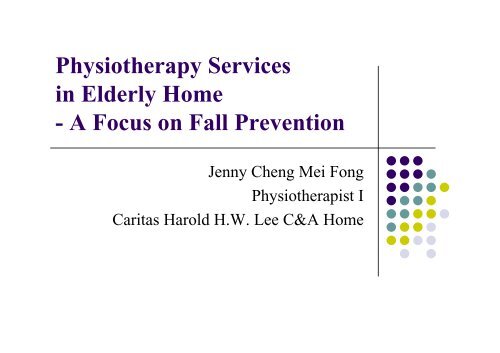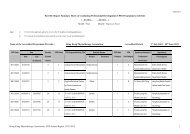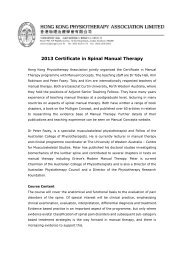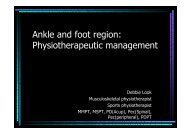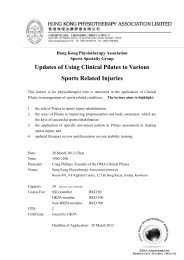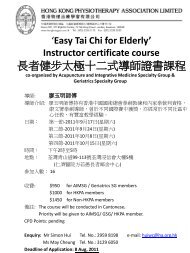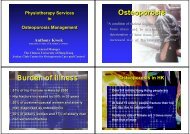Physiotherapy Services in Elderly Home - Hong Kong Physiotherapy ...
Physiotherapy Services in Elderly Home - Hong Kong Physiotherapy ...
Physiotherapy Services in Elderly Home - Hong Kong Physiotherapy ...
- No tags were found...
You also want an ePaper? Increase the reach of your titles
YUMPU automatically turns print PDFs into web optimized ePapers that Google loves.
Def<strong>in</strong>ition of fall• Un<strong>in</strong>tentionally com<strong>in</strong>g to rest on a lower level(Agost<strong>in</strong>i et al 2001)
Consequence of fall• Injuries• Morbidity and mortality• Psychological impact• Discouragement of activity by care providers• ↑Government medical expense• Increase staff time for assessment, observationand report<strong>in</strong>g
Epidemiology• The average nurs<strong>in</strong>g home residents are older, sicker andmore functionally dependent• Nurs<strong>in</strong>g home residents fall almost daily, rang<strong>in</strong>g upto50% of residents have fall history (Deanna Grajy Miceliet al 2005)• A mean of 1.5 falls /bed /year was reported (PhyllisTheodos 2003)• It was stated that the frail, high-risk residents tends to fallsecondary to gait disorders, weakness, dizz<strong>in</strong>ess andconfusion while the community-based person’s fall aremore related to the environment
Risk Factors Contributes to fall• Risk factor determ<strong>in</strong>ation is important→match specific<strong>in</strong>tervention with risk factors• Intr<strong>in</strong>sic factor:• Age• Visual and hear<strong>in</strong>g impairment• Sensory deficit• Cognitive impairment• Acute and chronic disease• Balance deficit• Neurologic conditions : stroke, park<strong>in</strong>sonism• Musculoskeletal condition: weakness, pa<strong>in</strong>, deformity, stiff jo<strong>in</strong>tetc• Foot disorder
Risk Factors Contributes to fall• History of previous fall- the strongest predictor offuture is a previous fall. [It was claimed that residentswith a history of two or more falls <strong>in</strong> the past 6 monthswere 84% more likely to fall than those with no recentfall history (Van Door et al 2003)]• three or four medications a day is associated with an<strong>in</strong>creased risk of fall• Use of medication especially antihypertensive drugs,psychoactive drugs, antidepressant, diuretics• Depression (3 times greater) and emotionally unstable
Risk Factors Contributes to fallExtr<strong>in</strong>sic factor• Environmental factor: Light<strong>in</strong>g: Wet floor / Polished floor: Uneven grounds: Obstacles: Footwear: High beds: Loosen rugs…• Assisted device – <strong>in</strong>correct choice, wrong size, lacks<strong>in</strong>struction to use, does not use the brakes dur<strong>in</strong>gtransfer on a wheelchair…
Risk Factors Contributes to fallOther factors1. Relocation – first week of admission, readmission after ahospital stay, chang<strong>in</strong>g a resident’s room2. Staff<strong>in</strong>g - Period with low staff<strong>in</strong>g levels e.g. meal time,shift, new staff3. Multitask <strong>in</strong>cidents – engag<strong>in</strong>g <strong>in</strong> other activity at thesame time
Intervention• Detect fall risk residents• Identify fall risk factors• Modify<strong>in</strong>g their fall risk factors• Prevent recurrent fall and fall-related <strong>in</strong>juries• M<strong>in</strong>imize the use of restra<strong>in</strong>t• Prevent falls while ma<strong>in</strong>ta<strong>in</strong><strong>in</strong>g autonomy and<strong>in</strong>dependence and postpone problems result<strong>in</strong>gfrom <strong>in</strong>activity
Role of physiotherapist-Identify<strong>in</strong>g resident at risk- Downton fall <strong>in</strong>dex/ Morse fall scale (primaryscreen<strong>in</strong>g by nurse)- Thorough physical and functional assessment- Time up and go test- Functional forward reach- T<strong>in</strong>etti Assessment Tool (19-24 <strong>in</strong>dicate a risk forfalls, below 19 <strong>in</strong>dicat<strong>in</strong>g a high risk)- Berg’s Balance Scale (a score below 45 <strong>in</strong>dicatefall risk)
Role of physiotherapist-Identify<strong>in</strong>g resident at risk- screen all newly admitted residents- screen when readmission from a hospital stay- screen when there is health or functional statuschanges- fall risk assessment regularly (at least once a year orafter a fall)
Interventionexercises ExerciseEnvironmentalmodificationTransfertra<strong>in</strong><strong>in</strong>gAssistivedeviceEducation(staff andresidents)<strong>in</strong>terventionrestra<strong>in</strong>tsMedicationmodificationHipprotector
Multifaceted Intervention• target the risk factor- reduce the number of risk factor- <strong>in</strong>dividualized- use resources available <strong>in</strong> the <strong>Home</strong>- no standard approach to treatment andprevention• Multifaceted <strong>in</strong>tervention for those with multiplerisk factor and those with high risk
Role of physiotherapist- <strong>in</strong>vestigatorPost fall assessment -prevent recurrent fall- history of fall(time/ location/ activity at the time of fall/anyassociate symptom e.g. weakness, pa<strong>in</strong>, fatigue,dizz<strong>in</strong>ess etc at the time of fall)- vital sign- physical exam<strong>in</strong>ation :visual, musculoskeletal andfoot assessment, neurological assessment- environmental issues-shoe wear
Role of physiotherapist- <strong>in</strong>vestigator- functional assessment- any change <strong>in</strong> medication- any change <strong>in</strong> mobility, mood recently- any change <strong>in</strong> cont<strong>in</strong>ence state- assess the condition of appliances e.g. walk<strong>in</strong>g aids,wheelchair- Other than gett<strong>in</strong>g the <strong>in</strong>formation from the fall-related<strong>in</strong>cident form, it is necessary to get <strong>in</strong>formation from theresidents or witness for <strong>in</strong>dividual analysis- It is important to assess the resident with<strong>in</strong> their liv<strong>in</strong>genvironment, not just <strong>in</strong> the PT gymnasium
Role of physiotherapist- <strong>in</strong>vestigator- Must be consider as a sent<strong>in</strong>el event, as they areoften a marker for disease- the w<strong>in</strong>dow of opportunity for learn<strong>in</strong>g the reasonfor a fall occurs immediately after the fall- if you don’t f<strong>in</strong>d out ‘why’ on the first fall, theresident will fall aga<strong>in</strong>, and no effective preventiveprogram is possible- further analysis of the fall statistics to note the trendsand the pattern e.g. peak time, peak month, commonplace, common reason, <strong>in</strong>jury pattern and severity etc)
Role of Physiotherapist-EducatorEducation to staff- cl<strong>in</strong>ical practice guidel<strong>in</strong>es/protocol describe theresponsibility of different professionals and worker- orientation to new residents on environment- require the commitment and participation of theentire staff- must have a sense of ownership and be providedfeedback- note the changes <strong>in</strong> behavior and functional status of theresidents- transfer techniques
Role of Physiotherapist-EducatorEducation to residents- encourage safe behavior- note the place where accident may occurEducation to relatives- cooperate <strong>in</strong> the <strong>in</strong>dividual care plan
Example of Content of educationgiven to staff1. Fall risk factor and consequence of fall2. Call bell with<strong>in</strong> reach3. Glasses with<strong>in</strong> reach4. Check hear<strong>in</strong>g aids <strong>in</strong> proper function5. Bed <strong>in</strong> low position6. Reposition of bed e.g. aga<strong>in</strong>st wall7. Reposition of residents e.g. close to toilets8. Shoe wear check<strong>in</strong>g9. Monitor for drugs’ side effect
Example of Content of educationgiven to staff10. Monitor for pa<strong>in</strong> medication needs11. Reevaluate bowel and bladder rout<strong>in</strong>e, weardiaper pants rather than diaper for those who can handletoilet<strong>in</strong>g <strong>in</strong>dependently12. Return to bed after lunch/ meal13. Involve resident <strong>in</strong> activities to <strong>in</strong>creasesupervision14. Transfer with 2 assistants whenever necessary15. Increas<strong>in</strong>g rounds to offer help and prevent dangerousaction……
Example of Content of educationgiven to resident1. 環 境 危 機 要 留 神2. 鞋 和 衣 物 要 稱 身
Example of Content of educationgiven to resident3. 助 行 器 具 要 穩 陣4. 有 病 睇 醫 生 、 有 病要 休 息
Example of Content of educationgiven to resident5. 藥 物 影 響 要 留 心6. 量 力 而 為 莫 強 行勇
Example of Content of educationgiven to resident7. 慢 慢 走 時 更 放 心慢 √轉 換 位 置 1 分 鐘8. 有 事 求 助 勿 怕 煩麻 煩 你 …
Example of Content of educationgiven to resident9. 運 動 強 身 更 醒 神
Role of physiotherapist- as a therapist1.Pa<strong>in</strong> control2.Exercise program- balance, strength program, endurance tra<strong>in</strong><strong>in</strong>g- <strong>in</strong>dividual vs group program- ?Frequency and duration ( it is claimed that a tra<strong>in</strong><strong>in</strong>gperiod of not less than 10 weeks will be more promis<strong>in</strong>g)[The ag<strong>in</strong>g musculoskeletal system reta<strong>in</strong>s itsresponsiveness to progressive resistance tra<strong>in</strong><strong>in</strong>g]3. Mobility and gait tra<strong>in</strong><strong>in</strong>g4. Prescription of appropriate walk<strong>in</strong>g aids and appliancesand proper usage
Role of physiotherapist- as a therapist5. post fall discussion with nurse and related profession foreach fall <strong>in</strong>cident- modify the care plan as necessary6. Plan for staff to walk, stand, sit to stand tra<strong>in</strong><strong>in</strong>g for theresident to ensure the muscle strength is ma<strong>in</strong>ta<strong>in</strong>ed7. Due to multiple factors (primary cognition), it wasbelieved that the residents would not cont<strong>in</strong>ue to exercise<strong>in</strong>dependently, therefore, it is important to <strong>in</strong>corporateexercise <strong>in</strong>to daily activities e.g. walk with assistancefrom the d<strong>in</strong><strong>in</strong>g room to their chair for meals or toilet<strong>in</strong>g,rather than br<strong>in</strong>g<strong>in</strong>g them <strong>in</strong> their wheelchairs as istypically done
Role of physiotherapist- as a therapist8. Give recommendation- change the daily rout<strong>in</strong>e of the client- visual rem<strong>in</strong>der for those with fall risk- environment modification- transfer skills of the care worker- consider to give hip protectors who has poorresponse to the fall prevention measures and has risktak<strong>in</strong>gbehavior- transitional mobility status e.g. on wheelchair, walk withassistance
Role of physiotherapist- as a therapist9. Choose appropriateappliance e.g. cushion toprevent forward slip10. Sometimes it may notpossible to select all theright <strong>in</strong>terventions on thefirst try, it is necessary tokeep on try<strong>in</strong>g to improvethe care
Role of physiotherapist- as a therapistExample of Environment ModificationThe more frail people are, the more they depend onthe environment for support, both before and after falls• Make sure of enough hand rail• Installation of monkey pole• A bedside commode• Night light• Bed aga<strong>in</strong>st a wall• Removal of loose carpets• Furniture changes• Change to a lower bed• Well-padd<strong>in</strong>g floor reduce the trauma of fall-must be<strong>in</strong>stalled dur<strong>in</strong>g construction
Role of physiotherapist- as a therapist11. Year review of the transferr<strong>in</strong>g technique bystaff12. Monitor<strong>in</strong>g the repair and ma<strong>in</strong>tenance of wheelchairand walk<strong>in</strong>g aids
Role of Physiotherapist- as negotiator1. On restra<strong>in</strong>t reduction2. Furniture placement3. Daily rout<strong>in</strong>e of the resident4. Facilities required5. Involvement of other professionals or staff*Fall prevention needs multidiscipl<strong>in</strong>e <strong>in</strong>put*
Consider successful• Not fall aga<strong>in</strong> with<strong>in</strong> 3 months• No <strong>in</strong>crease <strong>in</strong> the number of restra<strong>in</strong>er use• The <strong>in</strong>dependency and autonomy of the residents are notcompromised• Determ<strong>in</strong>e the basel<strong>in</strong>e fall rate, then compare over time,between units, and across <strong>in</strong>stitution, e.g. less falls, fewerhospitalization due to fall, less functional lose, less fallrelated <strong>in</strong>juries• Key factor <strong>in</strong> the success of the program was to ensurethat frontl<strong>in</strong>e staff members are aware of the changes andplans, otherwise all the effort will be worthless
On go<strong>in</strong>g process <strong>in</strong> our home• Increase residents education• Increase staff education• Educational board as visual rem<strong>in</strong>ders• More frequent review for restra<strong>in</strong>er use• A more well organized fall committee• Education to relatives especially shoe wear and cloth<strong>in</strong>g
Example 1- Madam Chan- F/85- dementia, depression, knee pa<strong>in</strong> that impair mobility,↑↑ confusion, frequent fall (11 times from October toDecember 2002)- Fall prevention approach· f<strong>in</strong>d out what cause fall· Intervention : Cognitive tra<strong>in</strong><strong>in</strong>g e.g. R.O. session 3times a week: everyday PT session →enhance physicalfunction to compensate for thedeterioration <strong>in</strong> cognitive function
Example 1……: arrange special duty (guardsman): do<strong>in</strong>g simple work <strong>in</strong> the office: don’t let her sleep for so long <strong>in</strong> daytime, sothat she has a better sleep at night to decreasewander<strong>in</strong>g at night: visual rem<strong>in</strong>der on her frame: refer medical officer for drugs adjustment because of<strong>in</strong>crease confusionOutcome – much decrease <strong>in</strong> fall <strong>in</strong>cidents, improve mobility andimprove cognitive function
Example 2- Madam Chow- F/90 on admission, now 93 years old- Dx:OA knee, mild <strong>in</strong>cont<strong>in</strong>ence, dementia- move <strong>in</strong> our <strong>Home</strong> <strong>in</strong> 24th August 2003 from other privateold age home- refer to physiotherapist after a fall on 24th August 2006while walk<strong>in</strong>g with Quadripod <strong>in</strong>side her room- on assessment: contracture of knee about 25 degree, acuteattack of OA knee, transfer need 1 m<strong>in</strong>imal assistant,unstable walk<strong>in</strong>g with any walk<strong>in</strong>g aids, not know<strong>in</strong>g herown limit-
Example 2……Intervention: pa<strong>in</strong> control and exercise program: tra<strong>in</strong> her to use wheelchair and teach her to“walk” when sitt<strong>in</strong>g on a wheelchair, teach transfer skill: seat belt for safer maneuver of wheelchair, she can unbuckle byherself: remove the leg rest because she forgot to lift up the footplatedur<strong>in</strong>g transfer and more focus on put on the brakes beforetransfer: use diaper for the early stage and regular toilet program: suggest hip protector and refer to SH OT, but refuse by resident: ice therapy by PCW daily: tra<strong>in</strong> her up to walk with a walk<strong>in</strong>g frame
Example 2…..Outcome:• She has a second fall on September 2003 dur<strong>in</strong>g walk<strong>in</strong>g while push<strong>in</strong>gthe wheelchair→ advise given and tra<strong>in</strong> her up to use walk<strong>in</strong>g frame and allow towalk <strong>in</strong>dependently with frame s<strong>in</strong>ce December 2003• She has a third fall on February 2004 because she forgot to use thewalk<strong>in</strong>g frame→advice given and recommend not to unfold the walk<strong>in</strong>g frame• On January 2004, she went out alone to buy tissue paper→ refer to welfare worker to make sure she has the th<strong>in</strong>gs for her dailyliv<strong>in</strong>g• She has no fall history after February 2004, now she can walk with awalk<strong>in</strong>g frame <strong>in</strong>dependently. She is able walk with a stick but she feelunsafe subjectively, therefore she is allowed to mobilize with thewalk<strong>in</strong>g frame.
Example 3• Mr. Cheng• M/ 85• Dx: park<strong>in</strong>sonism, arthritis, spondylolisthesis• Mentally sound• History: move <strong>in</strong> on 2nd May this year, claim to walkwith a stick <strong>in</strong> the previous home, but with fall history.Prilimary screen<strong>in</strong>g by nurse with fall risk and consultphysiotherapist for advice and temporarily on wheelchair
Example 3……• Assessment done by physiotherapist, c/o of bilateral knee pa<strong>in</strong>and back pa<strong>in</strong>• Unstable gait with a stick• Environment: cannot get up from a wooden bed and the bed istoo high for him• Intervention- a rollator was issued for mobility <strong>in</strong>side room and thengradually progress his walk<strong>in</strong>g tolerance- pa<strong>in</strong> control for knee and back- strengthen<strong>in</strong>g program (3 times per week) and walk<strong>in</strong>gprogram every day- change to a hospital bed which can adjust to a lower height, amonkey pole was issued for gett<strong>in</strong>g up from the bed- after about 2 weeks, he is allowed to walk <strong>in</strong>dependently onhis floor of liv<strong>in</strong>g, but not allowed to use the lift alone
Example 3……- however, Mr Cheng fell on early June 2006 and claimedbecause of slippery floor and weakness on the fall report- post fall <strong>in</strong>vestigation was done by the physiotherapistand found that he walk to toilet with his stick <strong>in</strong>stead ofthe rollator and the PCW forgot to give him a ur<strong>in</strong>al fornight and early morn<strong>in</strong>g use- further recommendation given: ask relative to take awayhis stick, make sure ur<strong>in</strong>al was given, shoe wear waschecked and was <strong>in</strong> good condition- there was no further fall <strong>in</strong>cidence and therapeuticprogram was still go<strong>in</strong>g on
Example 4• Ask the resident to walk nearthe rail and teach them how tofall• Mr. Chow with unstable gait,<strong>in</strong>sist to walk, refuse stronglyto use wheelchair (he had 20+fall <strong>in</strong> one year and all of themhad not resulted <strong>in</strong> any <strong>in</strong>jury)
The End


